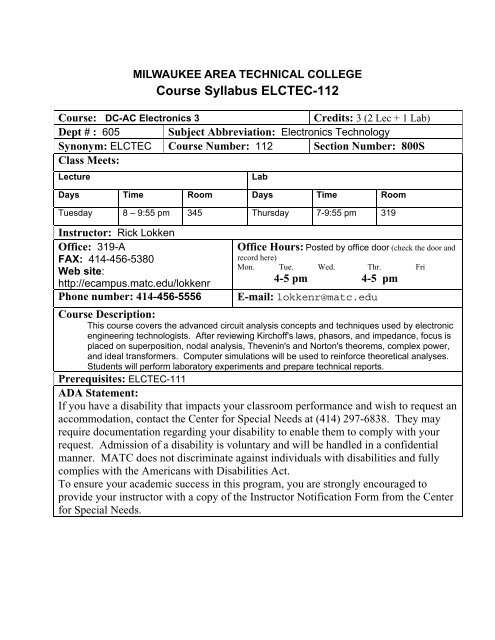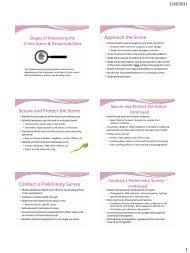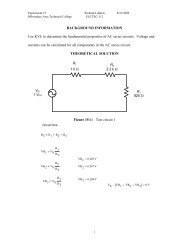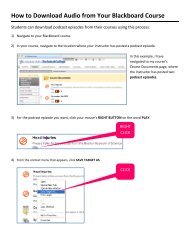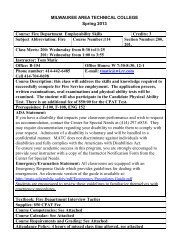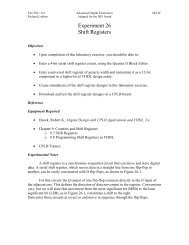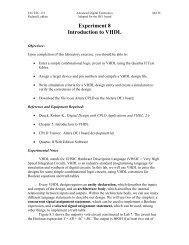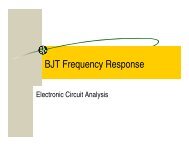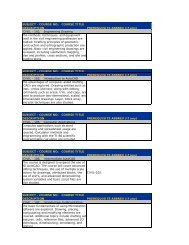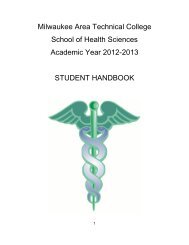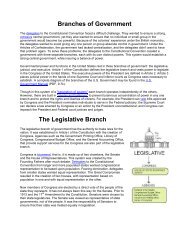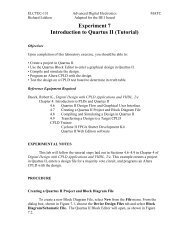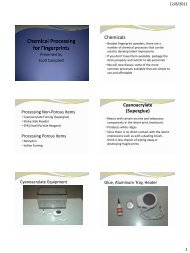Course Syllabus ELCTEC-112 - Milwaukee Area Technical College
Course Syllabus ELCTEC-112 - Milwaukee Area Technical College
Course Syllabus ELCTEC-112 - Milwaukee Area Technical College
Create successful ePaper yourself
Turn your PDF publications into a flip-book with our unique Google optimized e-Paper software.
MILWAUKEE AREA TECHNICAL COLLEGE<br />
<strong>Course</strong> <strong>Syllabus</strong> <strong>ELCTEC</strong>-<strong>112</strong><br />
<strong>Course</strong>: DC-AC Electronics 3<br />
Credits: 3 (2 Lec + 1 Lab)<br />
Dept # : 605 Subject Abbreviation: Electronics Technology<br />
Synonym: <strong>ELCTEC</strong> <strong>Course</strong> Number: <strong>112</strong> Section Number: 800S<br />
Class Meets:<br />
Lecture<br />
Days Time Room Days Time Room<br />
Tuesday 8 – 9:55 pm 345 Thursday 7-9:55 pm 319<br />
Instructor: Rick Lokken<br />
Office: 319-A<br />
FAX: 414-456-5380<br />
Web site:<br />
http://ecampus.matc.edu/lokkenr<br />
Phone number: 414-456-5556<br />
Lab<br />
Office Hours: Posted by office door (check the door and<br />
record here)<br />
Mon. Tue. Wed. Thr. Fri<br />
4-5 pm 4-5 pm<br />
E-mail: lokkenr@matc.edu<br />
<strong>Course</strong> Description:<br />
This course covers the advanced circuit analysis concepts and techniques used by electronic<br />
engineering technologists. After reviewing Kirchoff's laws, phasors, and impedance, focus is<br />
placed on superposition, nodal analysis, Thevenin's and Norton's theorems, complex power,<br />
and ideal transformers. Computer simulations will be used to reinforce theoretical analyses.<br />
Students will perform laboratory experiments and prepare technical reports.<br />
Prerequisites: <strong>ELCTEC</strong>-111<br />
ADA Statement:<br />
If you have a disability that impacts your classroom performance and wish to request an<br />
accommodation, contact the Center for Special Needs at (414) 297-6838. They may<br />
require documentation regarding your disability to enable them to comply with your<br />
request. Admission of a disability is voluntary and will be handled in a confidential<br />
manner. MATC does not discriminate against individuals with disabilities and fully<br />
complies with the Americans with Disabilities Act.<br />
To ensure your academic success in this program, you are strongly encouraged to<br />
provide your instructor with a copy of the Instructor Notification Form from the Center<br />
for Special Needs.
Lecture Textbook:<br />
Lab Textbook:<br />
Contemporary Electric Circuits, Strangeway, Petersen, Gassert, Lokken<br />
2 nd edition<br />
Lab manual to accompany Contemporary Electric Circuits, Lokken,<br />
Strangeway, Gassert and Petersen 2 nd edition<br />
Supplies:<br />
Bread Board (Required)<br />
Two (2) 3.5” Floppy Disks for Labs & Reports (Suggested)<br />
<strong>Course</strong> Competencies:<br />
Demonstrate background in steady state DC series parallel electrical circuit analysis.<br />
Demonstrate background in basic AC impedance and circuit concepts and analysis.<br />
Demonstrate techniques necessary to analyze and use ideal transformers in circuits.<br />
Demonstrate the techniques necessary to analyze an AC circuit in steady state using<br />
series parallel, nodal analysis, and fundamental network theorems.<br />
Demonstrate the techniques necessary to calculate the complex power of any AC<br />
electrical circuit.<br />
Demonstrate the proper use of electrical measurement equipment in the laboratory<br />
Generate technical laboratory reports..<br />
Attendance Policy:<br />
Attendance is highly recommended. Student is responsible for all material and assignments missed<br />
while absent. The student should notify the instructor as soon as practical about absences. Please read<br />
‘COURSE SYLLABUS ATTENDANCE SUPPLEMENT’.<br />
Withdrawals:<br />
Only under special circumstances will the instructor initiate a withdrawal from the class. It is the<br />
student’s responsibility to properly withdraw from the course. The last day for a student withdrawal<br />
from the course is two weeks before the end of the semester. Please read ‘COURSE SYLLABUS<br />
ATTENDANCE SUPPLEMENT’.<br />
Student Complaint Procedure: The student is responsible for following the procedure<br />
detailed in their official "Student Handbook.”<br />
Student Code of Conduct: See the Student Code of Conduct handbook that is<br />
available from Student Life.<br />
Academic Dishonesty Policy: Academic Dishonesty includes but is not limited to,<br />
cheating, collaborating with another without instructor approval, plagiarizing, stealing<br />
the work of another, falsifying records, and knowingly assisting another student on any<br />
of the above conduct. See the Student Code of Conduct handbook.<br />
Student Signature: ‘COURSE SYLLABUS ATTENDANCE SUPPLEMENT’.<br />
Student Outcomes Assessment (SOA) and MATC’s Core<br />
Abilities:
Student Outcomes Assessment (SOA) is a continuous quality improvement process that uses research to effectively<br />
verify and document where, when, and how well student learning takes place in the classroom, program, or<br />
department to enhance the coordination, design, and re-design of curriculum and its delivery. Assessment of<br />
students’ academic and technical achievement occurs in multiple forms throughout the students’ association with<br />
MATC, and also within the college.<br />
The assessment of students occurs upon entry into a program and within courses. Program goals and core abilities<br />
are also assessed. At the institutional level, the goals of the college, as well as the effectiveness and efficiency of<br />
programs, are evaluated cyclically. Assessment processes used at MATC provide valuable information that allows<br />
for data-driven decision making and program improvement.<br />
The Core Abilities are skills that allow students to continually adapt and learn. They have been called<br />
“employability skills,” soft skills, and professional attributes. You may not be tested for all of the Core<br />
Abilities directly, but you will demonstrate or apply them to complete lessons or to improve skills. MATC’s<br />
Core Abilities and indicators are listed below with those that apply to this course being denoted.<br />
Core Ability<br />
Applies to<br />
<strong>Course</strong><br />
Communicate Effectively<br />
a. Use effective oral communication skills<br />
b. Use effective written communication skills X<br />
c. Apply standard rules of language structure, including grammar and spelling X<br />
d. Listen actively to others X<br />
e. Derive meaning from text X<br />
f. Communicate in a bias-free manner<br />
g. Support viewpoints with evidence<br />
Collaborate with Others<br />
a. Demonstrate respect in relating to people X<br />
b. Cooperate and resolve conflicts effectively<br />
c. Participate in shared problem solving X<br />
Respect Diversity<br />
a. Acknowledge personal prejudices and biases<br />
b. Appreciate perspectives of people outside own background/culture<br />
c. Work collaboratively with persons from other backgrounds/cultures<br />
d. Demonstrate sensitivity to global issues<br />
Demonstrate Responsibility<br />
a. Attend classes as scheduled X<br />
b. Turn in quality work X<br />
c. Adhere to safety rules and regulations X<br />
d. Act professionally to fulfill job duties within chosen field<br />
e. Demonstrate flexibility and self-directedness in learning X<br />
f. Acknowledge a responsibility to the global community (cultural, economic, environmental,<br />
political)<br />
g. Practice environmental sensitivity in profession<br />
Think Critically<br />
a. Differentiate between fact and fiction<br />
b. Consider other viewpoints and perspectives
c. Present logical arguments<br />
d. Evaluate sources of information to solve problems X<br />
Utilize Technology<br />
a. Use technology to communicate X<br />
b. Solve problems using technology X<br />
c. Use appropriate technology to manage information X<br />
d. Recognize the impacts of technology<br />
Apply Math and Science<br />
a. Apply math concepts and principles appropriately X<br />
b. Apply scientific concepts and principles appropriately X<br />
c. Interpret meaning from quantitative data X<br />
d. Interpret meaning from scientific data<br />
SOA also occurs to improve the technical aspect of the occupational program and is facilitated in many of its<br />
technical and support courses. Therefore, there will be instances where you will be asked to submit select items<br />
(artifacts) from your personal professional records to your instructor. These exemplary artifacts will become part of<br />
departmental exhibits which will be reviewed by assessment evaluators seeking evidence of continuous<br />
improvement as you progress through the curriculum. It is important to understand that this process does not affect<br />
course grades and is strictly anonymous. It is suggested that you also retain copies of the artifacts that you submit to<br />
develop a personal professional portfolio which can be used during job interviews as an example of your abilities.<br />
The Electronic Technology courses where artifacts, generally in the form of lab reports, will be collected to enable<br />
improvement across the department will include:<br />
Elctec-110 DC/AC Electronics 1<br />
Elctec-120 Electronic Devices and Circuits<br />
Elctec-130 Digital Electronics<br />
Elctec-140 Microprocessors<br />
Depending on your program emphasis, instructors will also identify other select artifacts to be added to the<br />
department portfolio. This may include course final projects, software programs you may have written, and/or a<br />
“masterwork” that summarizes the technical aspect of your MATC occupational program experience.<br />
In addition, prior to graduation you will take a sample licensing examination that represents an industry standard.<br />
The exam will include 50 questions related to core electronic competencies and may contain an additional 25 items<br />
directly related to your program emphasis.<br />
To reduce interruptions during class time, please turn off all Cell phones, pagers and other<br />
noise generating electronics.
Grading Standards:<br />
Evaluation:<br />
Exam 1: 15%<br />
Exam 2: 15%<br />
Final Exam: 20 %<br />
Labs : 40 %<br />
Homework : 10 %<br />
Tests Can not be made, unless approved by<br />
instructor at least 24 hours prior to the<br />
exam.<br />
Lab Reports due one week after the lab<br />
was assigned, unless prior written<br />
approval is obtained from the lab<br />
instructor, or will be reduced by 25 % per<br />
week<br />
Homework is assignments are on<br />
Blackboard and are due dates are one<br />
week after assigned, late homework must<br />
have written prior approval from the<br />
instructor, or will be reduced by 50 % per<br />
week.<br />
Scale:<br />
93-100% = A<br />
90-93% = A-<br />
87-90% = B+<br />
83-87% = B<br />
80-83% = B-<br />
77-80% = C+<br />
70-77% = C<br />
65-70% = C-<br />
62-65% = D+<br />
55-62% = D<br />
50-55% = D-<br />
0-50% = U<br />
<strong>Course</strong> Calendar: <strong>Course</strong> calendar subject to change with notification from Instructor.<br />
WK Subject Reading Lab<br />
1 Review of Sinusoidal signals,<br />
phasors, KVL, KCL using<br />
phasors<br />
Reactance and Impedance of<br />
R,L,C<br />
9/08/09<br />
2 Series AC circuits; parallel AC<br />
circuits; admittance and<br />
susceptance<br />
Series and parallel equivalent<br />
circuits and conversions<br />
9/15/09<br />
3 AC series-parallel electric<br />
circuit analysis<br />
Superposition in multiple<br />
source AC electric circuit<br />
analysis<br />
9/22/09<br />
Chapter 8 Lab Procedures<br />
Assessment<br />
Homework<br />
9/03/09<br />
Section 9.1<br />
9.2<br />
Sections 9.3<br />
and 9.4<br />
<br />
15 KVL and Voltage<br />
Divider in AC Series<br />
9/10/09<br />
<br />
<br />
Analysis of Results<br />
and Executive<br />
Summary<br />
16 KCL and Current<br />
Divider in AC Parallel<br />
Circuits<br />
9/17/09<br />
<br />
Analysis of Results<br />
and Executive<br />
Summary
4 Complex Power in AC circuits<br />
How to Calculate Complex<br />
Power in AC Circuits<br />
9/27/09<br />
5 Complex Power Calculations in<br />
Series-Parallel Circuits.<br />
Power Factor Correction<br />
10/06/09<br />
6 Nodal Analysis of DC circuits<br />
10/13/09<br />
7 Nodal Analysis of AC circuits<br />
Review Exam<br />
10/20/09<br />
8 Delta-wye circuits, conversions,<br />
and circuit analysis<br />
Bridge Circuits<br />
(both AC and DC)<br />
10/27/09<br />
9 Thevenin Equivalent circuits<br />
11/03/09<br />
10 Norton Equivalent circuits (both<br />
AC and DC)<br />
Maximum Power Transfer<br />
11/10/09<br />
11 Ideal Transformers, concept of<br />
a coupled circuit<br />
Circuit Analysis with ideal<br />
transformers<br />
11/17/09<br />
Chapter 10.1<br />
and 10.2<br />
Chapter 10.3<br />
and 10.4<br />
17 AC Series Circuits<br />
with L and C<br />
9/24/09<br />
Full<br />
18 AC Series-Parallel<br />
10/01/09<br />
<br />
Analysis of Results<br />
and Executive<br />
Summary<br />
Section 11.3 20 Complex Power<br />
and Power Factor<br />
Correction<br />
10/08/09<br />
<br />
Analysis of Results<br />
and Executive<br />
Summary<br />
Section 11.3 Exam One<br />
10/15/09<br />
Section 11.4 22 Nodal Analysis<br />
10/22/09<br />
Analysis of Results<br />
and Executive<br />
Summary<br />
Section 12.2 23 Bridge Circuits and<br />
Delta-to-Wye<br />
10/29/09<br />
Analysis of Results<br />
and Executive<br />
Summary<br />
Section 12.3 24 AC Steady-State<br />
Section 12.4 Response of RLC<br />
Circuit<br />
11/05/09<br />
Sections 13.1<br />
and 13.2<br />
Full<br />
EXAM 2<br />
11/12/09
12 Three Phase Power<br />
11/24/09<br />
13 DC Bias of Transistors<br />
12/1/09<br />
14 DC Bias of Transistors<br />
12/8/09<br />
15 Review<br />
12/15/09<br />
Chapter 14 25 Thevenien<br />
Equvalent Circuits/26<br />
Norton Equivalent<br />
Circuits<br />
11/19/09<br />
Analysis of Results<br />
and Executive<br />
Summary<br />
Handouts 28 Transformers<br />
12/3/09<br />
<br />
Analysis of Results<br />
and Executive<br />
Summary<br />
Handouts DC Bias of Transistors<br />
12/10/09<br />
Full<br />
Final Exam<br />
12/17/09<br />
Optional References: Check Library for Additional References in Basic Electricity.<br />
Lab Reports (Due one week after lab was assigned).<br />
*******************************************************************************************<br />
***READ THE PREFACE OF THE LAB MANUAL PRIOR THE FIRST LAB.***<br />
*******************************************************************************************<br />
Lab Reports (Due one week after lab was assigned)<br />
1) Use a the grid pages in the lab manual. DO NOT use a loose leaf or Spiral bound notebook.<br />
2) Entries MUST be in Black Permanent Ink--Not Pencil. Entries to be made in single stroke block<br />
lettering.<br />
3) The Title and Project Number should be accurately recorded when starting a New Page. Each page<br />
must be numbered.<br />
4) All data is to be recorded directly into the grid paper. The inclusion of all elaborate details is<br />
preferable. Notes and calculations should be done on the grid paper, NOT on loose paper. In the case<br />
of an error, draw a single line through the incorrect data, date and initial. Do Not Erase or use<br />
correction fluid. All corrections should be initialed and dated.<br />
5) After entering your data, sign and date all entries. Witness or witnesses should sign and date each<br />
entry. The witness must observe the work that is done, and have sufficient knowledge to understand<br />
what they read. Names of all who were present during any demonstration should also be recorded.<br />
6) Never leave any White Space: "X" out or Crosshatch all unused space, and don't forget to initial &<br />
date it.
7) When pasting graphs or other information onto the grid paper, sign over the edge to show who placed<br />
the information in the book.<br />
ENTRY FORMAT FOR NOTEBOOK DATA<br />
1) Background Information *<br />
2) Theoretical Solution<br />
a) Manual theoretical calculations *<br />
b) Theoretical simulation solutions including circuit diagrams *<br />
3) Results<br />
a) Spreadsheet tables *<br />
b) Procedure<br />
c) Simulation solutions using actual component values including circuit diagrams<br />
d) Any other illustrations of results such as graphs<br />
4) Analysis of Results<br />
a) Discussion of results<br />
b) Error analysis<br />
c) Any other analysis<br />
5) Executive Summary<br />
* Student must complete these items before the scheduled laboratory session<br />
Lab Preparation<br />
Prior to the lab session, read the assigned lab. Write a brief lab purpose statement and write the<br />
procedures you will be following in the Lab. It is best to construct the data tables at this time. Complete<br />
the Pre-lab requirements.<br />
Lab Report<br />
Background Information<br />
<br />
<br />
One to two sentences stating what the experiment was about.<br />
Why was this experiment performed?<br />
Theoretical Solution<br />
The Theoretical Solution is a prediction of what ought to happen in the experiment. This<br />
is preferably a mathematical analysis which is idealized with the assumptions made in<br />
the introduction. The proper equations must be developed and the desired information<br />
extracted from them.<br />
One complete set of numerical calculations should be shown for the theoretical<br />
(predicted) results. If the same calculation is repeated several times, only show it once.<br />
If the information will be represented in graphical form, certain rules are to be followed<br />
when drawing a graph, and they are discussed later in this article.<br />
Be sure to state where all theoretical results are reported, usually in the Results table in<br />
the Results section.<br />
For this class, the theoretical solution should be done BEFORE the laboratory session.<br />
It is recommended that you work on it well in advance so that you have sufficient time to<br />
ask questions if you need to.
Results<br />
<br />
The following should be included in the Results section:<br />
o<br />
o<br />
o<br />
Procedure.<br />
• This section should give the reader a clear idea of the manner in<br />
which the investigation will be accomplished. It should cover:<br />
<br />
A statement of the problem and the method which will be<br />
used in its solution.<br />
o<br />
o<br />
Data = Measured Results<br />
Theoretical and Measured Results.<br />
An explanation of the apparatus to be used and the<br />
measurements which will be made, showing how<br />
and why the apparatus will produce the information<br />
desired. Any special apparatus used should be<br />
described sufficiently to acquaint the reader with its<br />
nature. Explanatory diagrams and drawings may<br />
be used.<br />
An explanation of the application of formulas used<br />
in the calculations. Fundamentals and basic theory<br />
may be assumed, but special formulas unique to<br />
the investigation should be explained and their<br />
derivation shown. All symbols used in any<br />
equations should be defined and their units stated.<br />
o<br />
<br />
All theoretical and measured results should be tabulated when<br />
possible. All related results, whether theoretical or measured,<br />
should be included in a single table. If the table is too large,<br />
break it up into multiple tables, but keep theoretical and<br />
measured results side-by-side.<br />
Sample Calculations<br />
<br />
This section should consist of a complete sample of each type of<br />
calculation involved in the determination of measured results.<br />
These sample calculations should first be shown in symbol form,<br />
each symbol being properly identified. Each set of sample<br />
calculations should be correlated with the table to which it applies.<br />
Analysis of Results<br />
<br />
This discussion is one of the most important sections of the entire report. As the name<br />
implies, it should be a complete analysis of the results obtained. The following topics<br />
should be included:<br />
1) Any original conclusions drawn as a consequence of the laboratory procedure and a<br />
study of the results obtained should be fully discussed. This includes why the<br />
circuit responded to changes in frequency. Look at both the magnitude and<br />
phase response.
2) Graphs<br />
a) All graphs drawn should conform to the specifications mentioned later in this<br />
article.<br />
b) When results are given in graphical form, the shape of each curve should be<br />
carefully explained. An explanation should state the causes for the particular<br />
shape the curve may have. If the slope is not constant, the nonlinearity should be<br />
discussed. If the area under the curve has meaning, or if the rate of change of the<br />
curve has meaning, it should be fully discussed.<br />
3) A discussion of the accuracy or reliability of the results: It is suggested that this<br />
section, when applicable, consist of a careful treatment of the effect upon the results<br />
of the following:<br />
a) Errors resulting from assumptions and idealizations because of physical<br />
limitations in the performance of the test. Significant differences between<br />
measured data and theoretical analysis MUST be resolved. Do not attribute it to<br />
experimental error.<br />
b) Errors in manipulation,<br />
c) Errors in observation, and<br />
d) Equipment limitations or failures.<br />
1. Steps taken to minimize such errors should be emphasized.<br />
4) A comparison of the measured results obtained with those which were expected from<br />
the theoretical analysis. Whenever the theory is apparently contradicted, probable<br />
reasons should be discussed. Experimental error is not an acceptable reason.<br />
Measurement errors must be corrected through re-measurement. Trends in the results<br />
should be stated.<br />
Executive Summary<br />
1) Context. One to two sentences stating what the experiment was about.<br />
2) Purpose: Why was this experiment performed?<br />
3) Key Results: This is a sub set of the analysis. Pick out two to three key results<br />
4) Concluding Statement: Review the laboratory objectives stated in the Introduction.<br />
Determine if the objectives were met and what they proved.
Grading Rubric<br />
Item 10 points 9 to 7 points 6 to 3 points 2 to 0 points<br />
General<br />
Requirements<br />
(including<br />
Background<br />
Information)<br />
On time, All pages<br />
numbered, Page<br />
Heading correct,<br />
Each page signed<br />
and dated, work<br />
recorded in ink,<br />
witness signed, no<br />
blank pages,<br />
pasted in<br />
information<br />
Missing one<br />
to three<br />
items<br />
Missing 4 to 7<br />
items<br />
Missing 8 to 10<br />
items<br />
Theoretical<br />
Results and<br />
Results<br />
Section<br />
Analysis of<br />
Results<br />
Executive<br />
Summary<br />
correctly signed.<br />
All items<br />
accounted for and<br />
accurate including<br />
procedure.<br />
All items<br />
accounted for and<br />
accurate.<br />
Completed and<br />
accurate.<br />
Missing one<br />
to three<br />
items<br />
Missing one<br />
to three<br />
items<br />
Missing an<br />
item<br />
Missing 4 to 7<br />
items<br />
Missing 4 to 7<br />
items<br />
Not clearly stated<br />
what was learned<br />
Missing 8 to 10<br />
items<br />
Missing 8 to 10<br />
items<br />
Incomplete<br />
Rules for Report Writing<br />
All report section titles must be capitalized, underlined or bolded, and centered on the<br />
page.<br />
Do not repeat procedures when writing the Analysis of Results.<br />
Make definite statements. Avoid statements which contain no information. Avoid trite<br />
expressions. For example, consider the statement: "The experiment was quite<br />
accurate." Quite is first of all a trite expression and secondly, it carries no hint of a<br />
number. It would be much better to say, "The experiment was 85 percent accurate."<br />
Write in the third person and past tense except the introduction, which is in the present<br />
or future tense. Try to avoid using, too often, the introductory phrases: It was found...; It<br />
was seen...; it was thought...; etc.<br />
Reports are not graded by weight, so do not make them longer than necessary. In fact,<br />
there are fewer chances to make spelling and grammatical errors in a shorter report!<br />
Number all important equations so they can be easily identified and found.<br />
Number all pages except page 1. Keep page numbers within the one inch margins. The<br />
Introduction begins on page 1.<br />
The symbol "%" is not to be used--the word is spelled percent.<br />
Numbers between one and ten are to be spelled out. Numbers above ten should be<br />
shown as a number.
Always refer to all tables and graphs. If a table or graph is not referred to, it is not<br />
important and therefore should not be in the report.<br />
Standard engineering abbreviations may be used.<br />
If information is quoted from another book, place the statement in quotation marks and<br />
use single spacing. State the author, title, publisher, edition, and pages referred to in the<br />
report body.<br />
Rules for Drawing Tables<br />
1. The table must have a title and label (table number) placed at the top left or center of the table.<br />
2. Draw as many blocks as there are columns and rows of information. It must be rectangular.<br />
3. The independent variable should be the first column on the left.<br />
4. Every column must have a heading. Include units if appropriate.<br />
5. If other columns are to be made from calculations or other results, the equations used to<br />
obtain this information and a sample calculation must be shown following the table.<br />
6. The paper can be turned ninety degrees clockwise (landscape) to draw the table, if necessary.<br />
7. Decimal points are placed in a vertical line.<br />
8. Explain each symbol used in a column heading. Give the dimensions or units of the symbols.<br />
9. Any column position left blank must be explained.<br />
10. When numbers in a column are repeated, do not indicate them with dashes or straight lines.<br />
Write out all numbers.<br />
11. Leave at least a one-inch margin on all sides. The page number must be within the one-inch<br />
margin, too.<br />
[See an example of a report table in the sample report later.]<br />
Rules for Drawing Graphs<br />
1. Every graph must have a title. It is usually placed in the top center position of the graph. The<br />
figure number and caption for the graph are placed below the graph.<br />
2. The abscissa is the independent variable (drawn horizontally), and the ordinate is the<br />
dependent variable (drawn vertically).<br />
3. Label the ordinate and abscissa correctly with the proper title and units. The ordinate should<br />
always be on the left.<br />
4. Do not run graphs into the margins.<br />
5. Choose scales that are easy to read and use most of the graph paper.<br />
6. Curves can be plotted with the graph in the vertical or horizontal position. IF the curves are<br />
drawn with the paper long side horizontal, the curve should be plotted so that the page is<br />
turned ninety degrees clockwise from the normal position to read it. The ordinate must still be<br />
on the left.<br />
7. When plotting a curve from the exact equation, do not show any points. State the equation of<br />
the curve on the graph.<br />
8. When plotting data points from an experiment, show all points. Do not draw a point-to-point<br />
curve. Plot an average smooth curve. The curve need not pass through any of the points.
9. If more than one curve is plotted on the same piece of paper, code the data points for each<br />
particular curve so they can be easily identified with that curve. The coding may be symbols<br />
such as: <br />
If there is the possibility of confusion, put a legend on the curve to identify the proper symbol<br />
with the proper curve.<br />
10. More than one ordinate may be used so that several curves can be plotted on the same paper.<br />
Each ordinate must have its own scaling and description. When more than one ordinate is<br />
used, the curves must be identified with the proper ordinate. Letters may be used for<br />
identification.<br />
11. When a family of curves is plotted, each curve must be identified for the particular parameter<br />
that is being varied.<br />
MATC is an Affirmative Action/Equal Opportunity Institution<br />
and complies with all requirements of the American With Disabilities Act.<br />
Page 13 of 13


